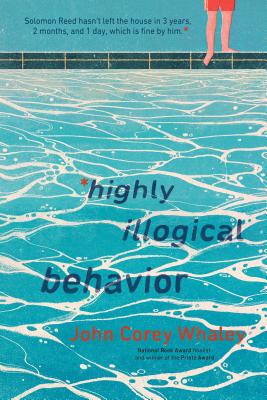craft review by Jesaka Long
In contrast to the rich yet static symbolism of Dolly Parton’s music in Dumplin’ (see Part 1 of this post here) where Dolly’s songs guide Willow Dean throughout the story, the main symbol in John Corey Whaley’s Highly Illogical Behavior evolves throughout the story, thus helping to elevate the stakes for the main character Solomon Reed.
Highly Illogical Behavior
In Highly Illogical Behavior, we learn right away that sixteen-year-old Solomon has not left his house “in three years, two months, and one day” (1). He has not even stepped foot outside into his own backyard. The last time Sol was seen in public, he was having such a severe panic attack that he stripped off his clothing until he was in just his boxer shorts and then ran out of class to the fountain in front of his school. Once there, “with his classmates and teachers watching, with the morning sun blinding him, he slowly leaned back until his entire body was under water” (4). At first, the dash to the fountain seems like it could have been a random choice, that it was just where a kid having a meltdown ran. What seems to matter most was that the spectacle led to Solomon’s subsequent need to remain inside his house at all times. However, that’s not true. We later learn a very key fact about Solomon and the fountain scene: “water calmed him down” (27). Although Sol doesn’t know why, being submerged in water helps him to recover, helps block things out.
The fact that water calms Solomon is essential to the setup for the introduction of the novel’s symbol: a swimming pool.
The Swimming Pool
 When Solomon’s grandmother, a successful real estate agent, comes over for dinner, she opens his computer to see what he’s up to and finds his web browser opened to research on inground swimming pools. (Her finding this was no accident.) Because of the context we have, the pool already seems like more than simple recreation. Having a pool in his backyard would mean that Solomon would have a bigger source of water to help calm him—and, most importantly, he would have to leave the house to access it.
When Solomon’s grandmother, a successful real estate agent, comes over for dinner, she opens his computer to see what he’s up to and finds his web browser opened to research on inground swimming pools. (Her finding this was no accident.) Because of the context we have, the pool already seems like more than simple recreation. Having a pool in his backyard would mean that Solomon would have a bigger source of water to help calm him—and, most importantly, he would have to leave the house to access it.
Sol’s grandmother adds another layer of meaning to the pool when she agrees to pay for it, but only if Sol invites Lisa, a former classmate who has reached out under the auspices of becoming his friend, to the house. At this point, the pool represents possibility: Can Sol make a friend? Can he step outside the house? Can he make it out of the house and into the pool?
Sol’s first effort in making the pool a reality is a success: Sol invites Lisa over and they enjoy their time together enough that Sol asks if she’d like to come back for another visit. And, it should be noted, this second instance of them hanging out is not a stipulation of Sol getting the pool. Simply by entertaining Lisa the first time, he had fulfilled his grandmother’s requirement.
This is where the use of the pool as a symbol begins helps heighten the story’s stakes. If Sol can interact with—and enjoy—a former classmate, then maybe he could have an actual friend. And if he can have a friend, then maybe he can make it out of the house and into the pool! And, if he can make it to the pool, what might be next?
Swimming Pool as Evolving Symbol
The construction of the pool commences, and the deeper the hole in the ground, the closer Sol gets to Lisa. Their friendship is solidified when she agrees to come over and hangout with him on a Saturday night, leading Sol to accept what he knew “to be absolutely true: He had a friend. And he was terrified of her” (65). The closer the pool becomes to a reality—an actual, filled body of water in the backyard—the more likely it seems Sol will be able to accomplish his mission. It feels so believable, so nearly tangible, that Sol will be able to get into the pool, his mom asks Lisa one thing: “Promise me you’ll stick around for as long as it takes to get him out there” (80). Everything feels heightened as the characters pull together to help Sol achieve his goal—in fact, it is no longer his goal, but everyone’s goal.
While the pool is being built, Lisa brings over her boyfriend, Clark, who becomes fast friends with Sol (the two of them having a big love of Star Trek in common). The three start hanging out almost every day at Sol’s house. Now Clark shares the goal of Sol being able to get into the swimming pool. One night, as Sol waves good-bye to Lisa and Clark, he realizes something has changed, something that won’t go away: “He wanted to follow them. He wanted to walk outside and follow them into the world” (127). This midpoint marks a huge shift for Solomon: it’s the first time he’s felt like he wanted to be not only outside, but far beyond, wherever it is that Lisa and Clark go when they leave Sol’s house.
The night before the pool is filled, it sits open and empty in the backyard, and all Sol can think about is “how useless it was without water—just a weird-shaped concrete hold in the backyard” (163). Tomorrow is the big day when Sol will step outside and fulfill the possibility symbolized by the pool. We all—Sol, his parents, his grandmother, his friends and, yes, the reader—want this to happen.
However, Sol can’t sleep, and in the dark of night he goes to the living room where he can see into the backyard. And he realizes he feels ready and steps outside and then continues walking until he is in the (empty) deep end of the pool. Which is where everyone is shocked–and wildly delighted–to find him the next day; he accomplished his goal of stepping outside.
Later, once the pool is filled with water, Sol and his parents as well as Lisa and Clark swim and splash and play until “their fingers turned so pruney they started aching” (174). It was the happiest time Sol’s family had experienced since Sol refused to leave the house three years, two months, and one day ago—plus the two months it took to build the pool. And, so on that day, the pool’s symbolism morphed from possibility to potential fulfilled and then to hope. Hope for more. If Sol could get this far, could he venture out to a friend’s house or a restaurant? Is there a future for Solomon that’s “normal,” where he can leave his house to do anything he wants? To even go to college?
Maybe. But everything in Sol’s life crashes when he learns that Lisa initially befriended him so that she could use her experiences with him as the basis for her college admissions essay. Hope for a different future is smashed. Sol can no longer go out of the house—and then the pool dominates the backyard as a painful symbol of what was, of what everyone had lost. Will Sol ever be able to go back out there? What, if anything, is possible now?
The book concludes with Sol’s grandmother having a medical emergency and Lisa and Clark using Clark’s van to help Sol actually leave the house without feeling like he’s left his garage. At the end of the stressful adventure, when he knows Grandma will be okay, Sol walks through the house, out to the backyard, and jumps in the pool with his clothes on. “Maybe it was the happiest moment of his life, but he couldn’t be sure” and, although it’s not a return to the outsized hope the pool once symbolized, there is a renewed hope for Sol, for them all (244).
Static and Evolving Symbols
In both Dumplin’ and Highly Illogical Behavior, the symbols feel essential to the characters and are present in their biggest moments: Willow when she’s on stage lip syncing to “Jolene,” and Sol jumping into the pool when he returns from being out of the house. For Sol, the pool feels even more powerful because it evolved from possibility to (big) hope to loss, back to (smaller) hope. It had, as Maass suggested, reversed, recurred, or been deployed in ways that enhance its significance (151). Of course, a symbol does not have to be as big as a pool to help heighten the stakes of a character’s goal—but perhaps the key to it working is that the symbol is visible, perhaps even something that feels inescapable. A character can turn off a Dolly Parton song, but can’t escape a pool, a building, a room in a house, a portrait that looms large in a hallway, almost anything they must see every day. It’s this omnipresence that can help a symbol evolve as the character’s journey shifts—and make it impossible for the character and the reader to dismiss.
Actions
- Identify something meaningful to your character, such as an object or song
- Note what this symbol means to your character at its first mention in your story
- Identify a key point in the novel, such as a mid-point. Has the meaning of the symbol changed for your character? If not, ask how your character might place a heightened importance on the symbol.
- Think about the end of your novel. Can you trace a shift or a journey for the symbol?
Jesaka Long writes young adult novels and short stories. She’s also a freelance editor and copywriter. Jesaka teaches creative non-fiction, screenwriting, and fiction classes to students in grades 6-12 through the non-profit literary organization Lighthouse Writers Workshop. One of her biggest loves is the Lighthouse Young Authors Collective, a group of twelve high school writers that she’s been leading for the last four years. Jesaka lives in Denver with her partner Kristi and their extraordinarily spoiled dog Effie P.


COMMENTs:
0